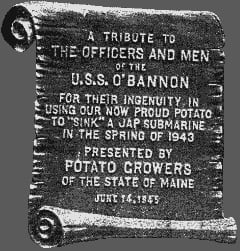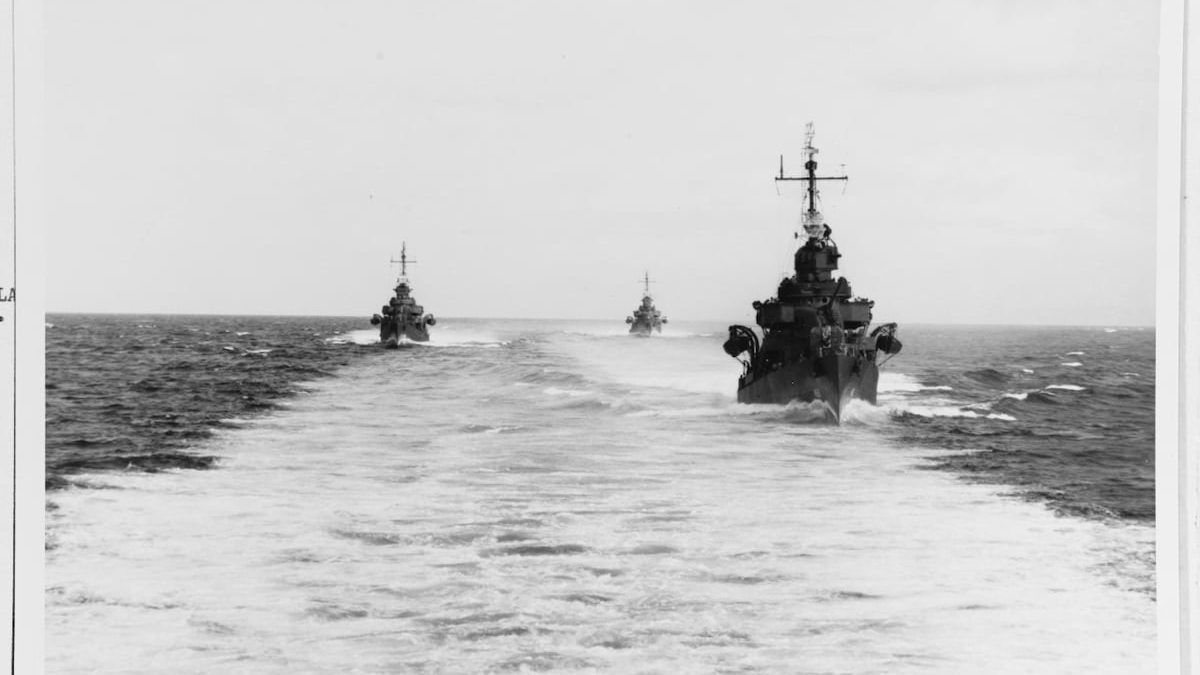The Fletcher-class destroyer O’Bannon, known as the “Lucky O,” had an illustrious World War II career, becoming the most decorated U.S. Navy destroyer of the war for its participation in protecting “The Slot.”
The Slot was a narrow sea lane through the Solomon Islands, of which U.S. naval forces violently battled the Japanese Combined Fleet for control. For their efforts, the destroyer and its crew earned 17 battle stars and a Presidential Unit Citation.
The ship also became, perhaps, the first and last to sink an enemy submarine through the ingenious use of potatoes — allegedly.
April 5, 1943
While patrolling The Slot on the night of April 5, 1943, O’Bannon made radar contact with a surfaced Japanese submarine, the RO-34, at a range of 7,000 yards.
The ship’s skipper, Lt. Cmdr. Donald J. MacDonald, cautiously maneuvered O’Bannon so close that one sailor recalled seeing the unsuspecting Japanese sleeping out on the deck “wearing dark shorts and dinky blue hats,” oblivious to the incoming Americans.
According to lore, the destroyer got a little too close and was unable to blast the submarine out of the water with its 3-inch deck guns, so its sailors threw the closest items they had on deck — potatoes from the spud locker.
In earnest, the swabs nailed the Japanese sailors left and right with the nightshades, the latter thinking the home-grown potatoes from Maine were hand grenades.
“This kept them very busy as they try to get rid of them by throwing them back at the O’Bannon or over the side of the sub. Thus occupied, they were too busy to man their deck gun which gave us sufficient time to put a little distance between our ship and the sub,” according to sailor Ernest A. Herr.
In reality, writes military historian John Wukovits in his book “Tin Can Titans,” “MacDonald simultaneously dropped depth charges and ordered his 40mm and 20mm guns to open fire.”
The enemy sub rose out of the water and settled by the stern a few moments later. The following day, aviators reported a thick oil slick at the location, and thus O’Bannon received credit for a probable sinking of the submarine.
The ship’s cook later remarked to MacDonald “that he thought he could have thrown potatoes at the boat,” they had been so close.
The myth begins
Certain members of the American press picked up the story and printed it as a tale of the destroyer sinking the sub with spuds.
Potato growers in Maine latched on to the story and even struck a plaque to honor the occasion, according to Wukovits.

The lore of the spuds vs. submarine lingered for so long after the war that MacDonald admitted, “I’ve been trying to drive a stake through this story for years.”
While he did maneuver O’Bannon close to the submarine, even a sailor with an arm that could throw “a football over a mountain” could not have managed to hit the submarine with anything, much less a potato.
“From that single remark [of the cook],” McDonald continued, “has grown the entire legend of the use of Maine potatoes to sink a Japanese submarine.”
However, O’Bannon didn’t need the false press. Its actions became the stuff of legends in its own right, with Adm. William “Bull” Halsey declaring, “The history of the Pacific war can never be written without telling the story of the U.S.S. O’Bannon. Time after time the O’Bannon and her gallant little sisters were called upon to turn back the enemy. They never disappointed me.”
O’Bannon was personally selected by Halsey to escort the U.S. battleship Missouri in Tokyo Bay for the Japanese surrender on Sept. 2, 1945, and was the first U.S. warship to travel from Tokyo to the Golden Gate Bridge in San Francisco after the war’s conclusion.
Claire Barrett is the Strategic Operations Editor for Sightline Media and a World War II researcher with an unparalleled affinity for Sir Winston Churchill and Michigan football.
Read the full article here


